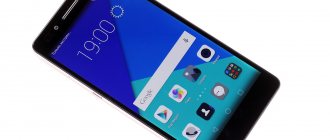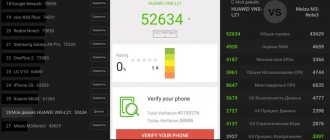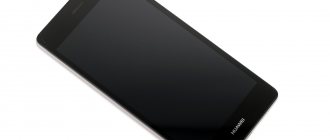Main characteristics of Honor 4X
| Screen | S-IPS, 5.5″, 720×1280, 16M colors, touch, capacitive, multi-touch 10 touches |
| Iron | 1.2 GHz, HiSilicon Kirin 620, 8 cores Cortex-A53, Mali-450MP4 |
| Memory | RAM 2 GB, ROM 8 GB, Micro-SD up to 32 GB |
| Mobile Internet | LTE cat.4 150/50 Mbit/s HSDPA 42.2 Mbit/s, HSUPA 11.5 Mbit/s |
| Mobile networks | LTE Bands 3,7,8,20 (1800, 2600, 900, 800) UMTS 900, 2100 GSM 900, 1800, 1900 |
| Battery | Li-Pol, 3000 mAh |
| Dimensions | 153 x 77 x 8.6 mm |
| Weight | 170 g |
| Camera | 13 MP, flash, autofocus, Sony, f/2.0 front: 5.1 MP |
| OS | Android 4.4 KitKat (4.4.2), Emotion UI 3.0 |
Remember the flagship killer OnePlus One (my review)? Five and a half inches, truly flagship characteristics... Of course, remember. Still heard. Now it costs from 20 thousand rubles for the younger version with 16 GB of memory.
Honor 4X is a smartphone of exactly the same dimensions. With an equally impressive battery and also with LTE support. Plus a memory card and dual-SIM capability—the One can’t boast of either. The rest, of course, is a little simpler. Weaker hardware, less memory, more modest screen resolution. He is not weak, no, this is not some kind of state employee. But weaker than One. But the price! The “official price” in the official store is 12 thousand rubles, including free delivery throughout Russia.
Honor 4X, of course, is positioned itself, without any pretense of being premium. Compare its cost with the cost of “tops” from the same manufacturer. Honor 6 - 24 thousand. Honor 6 Plus - 26 thousand. I’d better not say anything about Mate7 at all. Those. the difference is manifold.
What is the joke? What was broken, what was made worse? Synthetic tests give fewer parrots, a weaker camera, and a cheaper screen matrix. Another little thing - there is a film on the screen, there is no backlight for the Android buttons, the appearance is “not premium”. But the joke is that there are no fundamental deteriorations even in comparison with the flagships. The smartphone is very good.
Price
The official price in the official store, as I already said, is 12,000 rubles (more precisely, 11,990 of course). But the smartphone is not on sale yet. “Available in stock” May 15th. The question is in what quantity, is there enough for everyone? The device is not available in any other stores within the country. And it’s not a fact that it will appear somewhere else. The key feature of the new Honor devices is their reasonable price and sale only through their own online store, so as not to share money with intermediaries and retail chains.
In addition to the official store, Honor 4X can be bought, for example, on AliExpress. And in some wild number of options. 1 or 2 GB RAM, chipsets - both Kirin 620 and Snapdragon 410. Price - from 10 to 15 thousand (including delivery).
If you are planning to buy on Ali, be careful. You come across very strange price tags and performance characteristics. Here, admire: MTK6592, FullHD, 4 GB of RAM... Do you want this Honor 4X for 6,000 rubles? For some reason, I personally think that this is not the best option.
Competitors
Same size screen, good battery, LTE support, not crazy price.
Meizu M1 note and Xiaomi Redmi Note 4G have been removed from the list of competitors, because... These devices do not support the main Russian band LTE Band 7 2600 MHz.
What do we see? We see that in terms of price there are no competitors officially sold on our market at all. Both budget options, Lenovo K3 Note and Jiayu S3, are not officially imported to our country.
If I have forgotten anyone, please correct me in the comments to this review. For now, we are happy with what we have and are waiting for responses (i.e., most likely, devices based on MTK6752 and MTK6732 chips) from Fly, teXet, Alcatel and others like them. Or from MegaFon. Some kind of “MegaFon Login++ LTE”.
| Chipset | Memory | Screen | Battery | Cameras | Price | |
| Lenovo K3 Note | MTK6752 | 2+16+SD | S-IPS 1080×1920 | 3000 | 13+5 | 9-10 thousand |
| Jiayu S3 | MTK6752 | 2/3+16+SD | S-IPS 1080×1920 | 3000 | 13+5 | 10-12 thousand |
| Honor 4x | Kirin 620 | 2+8+SD | S-IPS 720×1280 | 3000 | 13+5.1 | 12 thousand |
| Lenovo Vibe Z | Snapdragon 800 | 2+16+SD | S-IPS 1080×1920 | 3000 | 13+5 | 16-25 thousand |
| Samsung Galaxy E7 | Snapdragon 410 | 2+16+SD | S.AML 720×1280 | 2950 | 13+5 | 17 thousand |
| Huawei Ascend G7 | Snapdragon 410 | 2+16+SD | S-IPS 720×1280 | 3000 | 13+5 | 17-27 thousand |
| OnePlus One | Snapdragon 801 | 3+16/64 | LTPS 1080×1920 | 3100 | 13+5 | 20-25 thousand |
| LG G3 | Snapdragon 801 | 3+32+SD | S-IPS 1440×2560 | 3300 | 13+2.1 | 20-30 thousand |
| Lenovo Vibe Z2 | Snapdragon 410 | 2+32 | S-IPS 720×1280 | 3000 | 13+8 | 22-27 thousand |
⇡#Camera
Honor 9X received a triple camera system, consisting of a main module with a 48-megapixel sensor with physical dimensions of 1/2'' (the size of an individual pixel is 0.8 microns) and optics with an equivalent focal length of 26 mm and an aperture of ƒ/1.8, wide-angle module with an 8-megapixel sensor and optics with an EGF of 13 mm and an aperture ratio of ƒ/2.4. The third camera, with a resolution of 2 megapixels, is needed to obtain information about the background to create an artificial blur effect.
Phase detection autofocus only works with the main camera, there is no optical stabilization system, and there is a single LED flash.
| On the left is an example of shooting with an extended viewing angle, on the right is with a standard | ||
Above you can see examples of shooting with the main and wide-angle modules - no “hybrid” systems are used, images are taken with a resolution of 12 megapixels with a standard viewing angle (by default, you can set the 48-megapixel mode in the settings) and 8 megapixels with an extended one. The quality of shooting with a wide-angle module leaves much to be desired even under good lighting conditions - the picture is soapy, poorly detailed, with very strong spatial distortions; and in the dark he is completely incapacitated. The only good thing is the really wide angle. The main camera performs at the usual high level for this sensor. It’s a little surprising that the Honor 9X hasn’t added a 2x “hybrid” zoom, which is available on all smartphones with a Quad Bayer sensor; such a decision cannot be explained except by marketing quirks.
| On the left – shooting without the use of “artificial intelligence”, on the right – with its use | ||
Yes - using machine learning technologies, the smartphone recognizes many scenes and adapts the picture taking into account this knowledge. As a rule, the same operations are performed - contrast and saturation are raised.
Portrait mode in Honor 9X works well - the separation of plans occurs with a minimum number of artifacts, there are numerous bokeh effects (from circles to hearts), a disable and customizable beauty feature. There is only one drawback - the focal length of the camera leads to a noticeable distortion of the proportions of the face when shooting close-up; The camera is more suitable for long shots, even half-length portraits look “flattened”.
| On the left is a picture in normal mode, on the right is in night mode | ||
There is also a night shooting mode that is common not only for the company’s older cameras - multi-frame exposure followed by stitching into one frame and expanding the dynamic range, reducing noise levels and tightening up detail. In this case, there is no need to talk about some kind of exorbitant level - it’s not always possible to take even an unblurred frame. And the night mode only works with the main camera with a standard viewing angle. But sometimes this system pulls out a photo in hopeless darkness—check out the bottom example. In this case, Honor 9X set the shutter speed to 20 seconds - and at the same time took a handheld photo without blur. In other cases, even 4-5 second shots ended with images with blurry details.
The camera application is typical for smartphones with EMUI: horizontal navigation, a set of familiar settings. A “professional” mode with manual settings is available, but without the ability to shoot in RAW. There is HDR (you need to turn it on forcibly; in the basic format it is disabled, but when you activate the AI assistant, the smartphone will in any case stitch together pictures from several frames with extended dynamic range), panorama stitching.
| On the left are pictures taken on Honor 9X, on the right are pictures taken on Xiaomi Redmi Note 8 Pro | ||
The set of cameras itself is quite good and interesting for its class, especially taking into account Huawei’s skills in terms of software processing. But the next Honor smartphone does not occupy the usual pinnacle of “best shooting quality in its class”. I tested the Honor 9X at the same time as the Redmi Note 8 Pro and had the opportunity to compare these gadgets head-to-head. Examples above - Honor 9X has a slight advantage only in night mode, where it better draws out shadows and enhances detail. In all other scenarios, Xiaomi's creation performs better - not to mention the possibility of 2x zoom and a special camera for macro photography. By the way, a detailed review of Redmi Note 8 Pro will be released soon.
Gallery of pictures
View all images (25)In video shooting, the Honor 9X does not shine at all. The maximum resolution is Full HD with a frame rate of up to 60 frames per second. There is no digital stabilization. It is possible to shoot with both a normal viewing angle and an extended one. Video quality is average.
The retractable front camera has a 16-megapixel sensor and ƒ/2.2 aperture optics. If you don’t try to turn on artificial background blur, portraits turn out quite good, but as soon as you activate the specialized “portrait” mode, everything goes to waste - Honor 9X is not able to properly separate the object from the background, alas. You can see everything for yourself. It should also be said that the focus is fixed (at a normal distance), there is no flash (besides the on-screen one).
Appearance
| Weight | 170 g |
| Size | 153 x 77 x 8.6 mm |
| Protection | No |
A black smartphone has been officially announced for sale. I tested a device with a black front and white everything else. You can also find references to golden-colored devices.
Big. Plastic. Matte. Slightly creaky. Doesn't look very stylish.
The back cover is removable, underneath there are slots for two Micro-SIM and one Micro-SD memory card. The battery is not removable.
What's under the lid
The plastic looks interesting. Into the notch. Competently. The smartphone does not break out of your hands, despite its considerable weight. Not like some.
Boring details about appearance
Before. Screen. Above the screen are sensors, a front camera, a speaker, and a dim LED.
Below the screen are Android touch buttons. Drawn clearly and boldly. Visible well. Alas, no backlight at all.
Rear The camera with flash is in the corner. I don’t like this arrangement, my finger is always trying to fit into the frame.
Top. 3.5mm audio output and noise canceling microphone.
Bottom. Micro-USB connector, speaker, main microphone.
Right. Buttons - volume rocker and power-lock.
The left is empty.
Design
Huawei Honor 4X is a large smartphone, similar in size to the older Honor 6 Plus model. The only difference is in the characteristics and case materials used. The hero of today's review has plastic and protective glass (brand and generation are not specified) on the front side.
Along the perimeter, a plastic edge protrudes slightly above the front surface. It does not affect ease of use in any way, but it protects the screen from scratches if the device is lying, for example, face down on a table.
Unlike the younger Honor 4C model, the cover here can be easily removed - there is a recess for a fingernail on one of the ends of the device.
Recess for opening the lid
Under the cover you can immediately see the battery (non-removable) and connectors for Micro SIM cards (both with LTE support), as well as a slot for installing a memory card.
The back cover is not just matte, but, as the manufacturer claims, it is processed in a special way, resulting in the surface imitating the texture of silk. It sounds impressive, but in practice it looks kind of cheap.
However, there is a plus here - such a coating is very difficult to scratch, so the back of the device will always look like new.
The left side of the smartphone is completely empty, and the right side is occupied by the volume keys and the power button. They are again made of plastic, play slightly (this is normal for almost all phones), but have a clear and soft movement.
On the top side there is a 3.5 mm headset jack, as well as a tiny hole for a microphone. The bottom end is occupied by a Micro USB port with support for connecting USB peripherals (flash drives, keyboards, etc.), another microphone and holes for a speaker. Of the new line, only Honor 4X can boast, so to speak, of the correct placement of a multimedia speaker. Its counterparts have a speaker located on the back, which can cause the sound to be muffled when the device is lying on a flat surface with the screen facing up.
In our case, these problems do not exist. The external sound is loud, it will be difficult to miss a call even on the street, in a noisy place. If the volume is set to maximum, then in a small room a suddenly loud ringing sound can, so to speak, be a little surprising.
Above the screen there is a front camera, a speaker, a proximity sensor and a sensor responsible for adjusting the brightness depending on the ambient light. This sensor is rarely found in budget devices, but here the manufacturer did not skimp, which is certainly nice.
The display glass has an oleophobic coating, which does little to protect the screen from the accumulation of fingerprints. In flagships, such protection is implemented much better, but this is still not the case here, although the finger glides across the glass quite easily - not as it happens on other budget devices.
The control keys here are touch sensitive and are placed on an empty surface under the screen. In general, Huawei is surprising. In one device, the touch keys are part of the system interface (Honor 6 Plus); in others, they are located separately. It is strange that the manufacturer does not have a unified approach to smartphone construction. Or maybe this is some kind of clever way to save on something?
I'll repeat it again. The device is large, which is normal for 5.5-inch devices. In the table below you can estimate the dimensions of the smartphone, comparing them with its competitors.
| Length | Width | Thickness | Weight | |
| Huawei Honor 4X | 153 | 77 | 8,6 | 170 |
| Sony Xperia T3 | 150,7 | 77 | 7 | 148 |
| LG G3 Stylus | 149,3 | 75,9 | 10,9 | 163 |
| Lenovo Vibe Z2 | 148,5 | 76,4 | 7,8 | 158 |
Five color variations will be available for sale: completely black, white (as we tested), coral, sand-gold and light blue. The bright colors look interesting and will likely be available later.
Internals (iron)
| AnTuTu | 30841 (v5.7) |
| Chipset | HiSilicon Kirin 620 |
| Cores | Cortex-A53 8 x 1.2 GHz |
| GPU | Mali-450MP4 |
| RAM (free) | 2 GB (1.35 GB) |
| ROM (free) | 8 GB (3.5 GB) |
| Micro-SD | Up to 32 GB |
Your own “branded” chip, sixty-four bit. In addition, it is also used in Huawei Honor 4C and Huawei P8 Lite devices.
By its components, by the way, the HiSilicon Kirin 620 chip resembles the Qualcomm Snapdragon 615 (HTC Desire 820, Sony Xperia M4 Aqua, ZTE Blade S6) - the same cores in the same quantity, the same video accelerator. Only Snapdragon has the Big.LITTLE system (two four cores operating at different maximum frequencies); here, it seems, there is no such thing.
I am more than satisfied with the performance of the device. I don’t plan to simulate the explosion of an atomic bomb, but there is enough power for more modest needs.
2 GB RAM. For a flagship it’s no longer serious, but for a device that costs half the price of a flagship it’s just right. It looks like a new de facto standard for such semi-flagships.
There is not much built-in flash memory, but you can install a larger memory card and assign it as the default memory - there are no problems here.
I tried to install a 64 GB memory card - it didn’t work, the smartphone simply didn’t see it.
The set of sensors is normal. Accelerometer, compass, gyroscope, light and proximity sensors.
My tests for elementary actions:
Pay attention to the speed of calculating Pi. Amazingly fast. And I have no explanation for this phenomenon.
| Chipset | Pi | Nerdy Birds | Big Page2 | Heavy Book2 | |
| Huawei Honor 4X | Kirin 620 | 4.25 | 7.87 | 6.42 | 5.32 |
| Huawei Ascend G7 | Snapdragon 410 | 11.50 | 7.81 | 6.63 | 5.33 |
| Lenovo P70 | MTK6752 | 10.55 | 6.81 | 4.44 | 3.59 |
| Sony Xperia Z3 | Snapdragon 801 | 6.39 | 6.52 | 5.75 | 3.70 |
| Meizu MX4 | MT6595 | 6.72 | 7.13 | 4.25 | 3.78 |
| Fly IQ455 Octa EGO Art 2 | MT6592 | 14.28 | 7.67 | 6.88 | 4.52 |
| Fly IQ4514 Quad EVO Tech 4 | MTK6582 | 17.82 | 8.31 | 7.65 | 6.15 |
Synthetic parrot tests (screenshots, 5 pcs.)
Review of Honor 4X – a powerful mid-ranger
The Honor line of mobile devices recently became an independent sub-brand of the Chinese company Huawei. On the occasion of this change in the life of the manufacturer, Honor 6 Plus was released, which in fact became the first device of the separated brand. Fortunately, the addition to the lineup did not take long to arrive and soon the Honor 4X appeared, a review of which we present to you today.
Introduction
For those who are not in the know, we inform you that smartphones under the Honor brand are available only in the official online stores of the Chinese company, thanks to which the devices are sold at the official retail price without markup by intermediaries. The decision to separate this line was made in order to provide tough competition to companies such as Xiaomi and One Plus, and thereby allow Huawei to concentrate on developing devices in the mid and, for the most part, high price range. Honor models, in turn, are aimed at a young audience who look at the technical characteristics and affordable price. For example, the price of Honor 4X is $245, and in Russia the gadget received a price tag of 11,990 rubles - an ideal solution for the money, taking into account all the capabilities of the smartphone. Well, now about the model in detail - let's start with the Huawei Honor 4X review.
Appearance
In terms of design, Honor 4X does not stand out with any special features among competing models from other manufacturers. Nevertheless, the assembly of the device is performed at the highest level. The user will not notice any creaking or play in the case after purchase. The back cover has a textured surface that gives the appearance a highlight. The smartphone is equipped with a 5.5-inch screen with HD resolution, which occupies 75% of the front panel. The brightness of the display module is more than enough to see the elements on the screen even in direct sunlight. The pixel density is 267 ppi. Unfortunately, there is no Gorilla Glass protection, and therefore it is better to purchase a film, protective glass or case in advance.
A little above the display there is a 5 MP front camera, and next to it there is a light and proximity sensor, and a notification indicator. Below the screen looms an Android Lollipop-style touch navigation pad. By the way, the device should soon receive a notification about the availability of Lollipop for download, and those who can’t wait can download the beta firmware with Android 5.1 on our website using the link.
The only negative with touch buttons is that they are not backlit. On the right side there is a volume rocker, and a little lower there is a power button. At the bottom end there is a MicroUSB port along with a conversational microphone and the main speaker.
At the back you can see the peephole of a 13 MP camera with an LED flash located in the upper left corner, and a little lower there is an engraving with the Honor logo. As we mentioned above, the lid is textured and this provides excellent grip, so to speak, on the hand. It is worth noting that the back cover is very durable and when opening you can notice quite a bit of bending, as well as the absence of squeaking.
Thanks to the texture, the smartphone collects a small number of fingerprints. If you remove the cover, the user will have access to two MicroSIM slots with support for 4G LTE and a slot for a MicroSD card up to 32 GB. In terms of colors, the smartphone has only 2 options: black and white. The weight of Honor 4X is 170 grams, and the overall dimensions are 153 x 77 x 8.6 mm.
Basic Specifications and Interface
Despite its price, Honor 4X has quite attractive software and hardware capabilities. The smartphone is equipped with an 8-core HiSilicon Kirin 620 processor with a frequency of 1.2 GHz, a Mali-450MP4 video accelerator, 2 GB of RAM and 8 GB of internal storage. The device is powered by a 3000 mAh battery. As already mentioned, the device has 2 cameras of 13 MP and 5 MP.
The popularity of 4G is undoubtedly gaining momentum, and therefore the presence of this option in Honor 4X will be appreciated by many travelers, and ordinary users in general. Many people use one card for calls and another for the Internet, so the presence of two SIM card slots is also a big plus.
It's worth noting that 4G can be accessed on both cards, which is very rare. Most budget devices with dual SIM support offer only one card slot with 4G LTE connectivity.
At the time of writing, Honor 4X runs Android 4.4.2 KitKat and EMUI 3.0. Although these are not the latest versions of the software, the operation of the device leaves no complaints. As we mentioned above, Lollipop for smartphones will be released in the near future, you just need to be a little patient.
For the most part, the EMUI user interface resembles the iOS operating system. Huawei's proprietary shell offers a more intuitive and customizable option than pure Android, which leads to the presence of some useful functions.
The phone settings include functions such as one-handed control, gesture control and adding control buttons to the bottom of the screen. Of course, additional buttons will take up extra space on the display, but in practice this function can be quite useful.
Like the latest models from the Chinese brand, Honor 4X has a DTS sound amplifier. Enabling this function is available in the sound settings menu. Of course, this will not particularly affect the sound from the speaker, but listening to music through headphones will be more enjoyable.
Performance
For most smartphones in the budget price category, the power parameter leaves much to be desired, but in the case of Honor 4X this can be said to be its main feature. According to the results of testing the device in Geekbench 3 in multi-core mode, the mark fell on 1705 points, and this is an order of magnitude higher than most mobile devices from other manufacturers were able to score.
Honor 4X also exists in a version based on the Qualcomm Snapdragon 410 chipset. Below are the results of testing this modification in AnTuTu and 3D Mark.
In practice, the performance of the smartphone brings surprises with power-hungry games like Real Racing 3 and Asphalt 8. The 64-bit Kirin 620 chipset played a cruel joke here because support for 64-bit architectures is implemented in the Android version of Lollipop, and therefore the potential of the processor cannot be fully revealed.
Battery autonomy
Removing the back cover of the Honor 4X case, the user will see a massive non-removable 3000 mAh battery, and in combination with a 5.5-inch 720p screen, its service life should be extremely high. And this is indeed true. The average user of mobile devices is provided with almost a whole day of autonomy with frequent calls to the device. Under light and medium loads, the smartphone can withstand a day and a half, and up to two days of battery life can be achieved using energy-saving modes. Naturally, when Dual-SIM is turned on, the battery will last a little less.
When watching a video for 90 minutes and 100% screen brightness, the Honor 4X battery charge dropped by only 22%. For comparison, under the same conditions, the Samsung Galaxy Note 4 turned out to be 3% less power-consuming, and the iPhone 6 Plus was 5% more power-hungry. Not a bad result for a mid-range smartphone, and with the arrival of the Android update to Lollipop, the battery life should increase.
Basic functions of a smartphone
What do they mainly use a smartphone for, and mobile phones in general, if not for making calls, sending messages and, of course, fast access to the Internet. The earpiece fully copes with its function. The sound during a conversation is quite loud and clear, and an additional microphone will isolate the user from unnecessary noise. The main microphone also raises no complaints. The interlocutor will hear everything perfectly. The main speaker at the bottom end is loud enough to not miss an incoming call or message.
Thanks to Emotion UI, the keyboard in Honor 4X is more convenient than the alternative from AOSP and Google. The large keys are properly spaced across the screen, and switching between languages is accomplished by simply holding down the spacebar.
Surfing the Internet is fast and smooth both through Google Chrome and the standard browser, and reading news on the 5.5-inch screen is a pleasure.
Camera
Honor 4X has a 13 MP main and 5 MP selfie camera at its disposal. The rear camera, considering the price, does its job surprisingly well.
It is worth noting that by default the smartphone has 10 MP with an aspect ratio of 16:9 and in order to go up to 13 MP you need to sacrifice the ratio and go to 4:3. The camera software is exactly the same as that of the premium Honor 6 and Huawei Ascend Mate 7. All standard effects and modes inherent in smartphones of the Chinese brand are present.
Of all the functions, we can highlight the speed at which the extra shot is triggered. By double pressing the volume down button, the camera starts up, the necessary settings are accepted and voila, the photo is ready. The whole process takes just over a second.
With sufficiently good lighting, the photos turn out good, bright and natural. In very bright conditions the colors wash out a bit. There is some noise when the image is enlarged. The smartphone records video in Full HD resolution and 30 frames per second.
Of course, you shouldn’t expect super high-quality video, because remember the price of the device. The front 5 MP camera is quite enough for selfies and video conversations. Clear selfies and HD video recording are all that the average social media user needs.
Conclusion
Honor 4X is a shining example of the relationship between quality and price. For a low price, the smartphone offers a 5.5-inch screen and powerful hardware, the performance of which is more than enough for most everyday tasks. The intuitive EMUI 3.0 interface, 2 GB of RAM and a 64-bit processor put the device head and shoulders above budget solutions from other manufacturers. A 3000 mAh battery will provide the phone with battery life for 1-2 days. Working with 4G LTE on two SIM cards is also a huge plus that not many can boast of. The only disadvantage of the smartphone is the lack of Gorilla Glass, instead of which there is a standard screen protection that collects a lot of fingerprints.
Communication with the outside world
| 4G | LTE cat.4 150/50 Mbit/s Bands 3,7,8,20 |
| WiFi | b/g/n, 2.4 GHz |
| Bluetooth | v4.0, A2DP |
| USB modes | MTP + Storage |
| USB-OTG | + |
| MHL | — |
| NFC | — |
LTE can be assigned to any of the SIM cards.
Wi-Fi, alas, is single-band. The smartphone does not see the 5 GHz network.
Otherwise, everything that is works as it should work.
When accessing via USB in storage mode, only the Micro-SD memory card is visible.
Screen
| Matrix | S-IPS |
| Diagonal | 5.5″ |
| Permission | 720×1280 |
| Multi-touch | 10 |
| Max white brightness | 450 cd/m2 |
| Min white brightness | 7 cd/m2 |
| Contrast | 750:1 |
| Color temp. | 7300-11400K |
| Gloves | No |
To my great surprise, it turned out that there was a film glued to the screen. And I thought everyone had already gotten over this disease. But no. The film is glued with high quality. And overall a very good film. The kind that doesn't scratch too easily. I asked Huawei if this is how it should be? Yes, they say. That's how it should be. The device will be sold together with the film already pasted.
If you look closely at the photographs, for example, from the iXBT review, you can also see this film there.
OK. Film is just film. Since it was factory, I didn’t bother tearing it off. The only pity is that there is no oleophobic coating on the film. It gets covered with fingerprints quickly and is difficult to wipe off.
Overall the screen is of average quality. Nothing outstanding, but not worthy of angry words either. Very bright, by the way.
Here and there in the descriptions of the device you can find a mention that it supports working with gloves. If so, then the corresponding menu item was hidden too cleverly. I didn't find it. By default, it does not respond to gloved fingers.
Display
Honor 4X received a 5.5-inch display with a resolution of 1280x720 and a pixel density of 267 per inch, despite the low resolution, pixelation is not obvious. The IPS matrix should provide the screen with wide viewing angles, however, they are average, noticeable shifts in shades depending on the position of the smartphone.
Multi-touch technology supports up to ten simultaneous touches, the brightness can be set either independently or rely on auto-tuning. The maximum brightness level is enough for comfortable reading of information from the screen outdoors. But the minimum brightness is not even enough for reading in the dark, so you can set it higher. I like it even better.
There is an oleophobic coating, which is quite weak: fingerprints remain, but are quickly and easily erased.
Battery
The battery is capacious - 3000 mAh. The average result of battery tests is 145% of the standard. Which is very good.
| Full discharge time | Discharge in an hour | |
| Video | 10:30 | 9.5% |
| Video HD | 8:20 | 12.1% |
| Easy game | 6:50 | 14.8% |
| Telephone | 19:10 | 5.2% |
| Music | 33:00 | 3.0% |
| GPS on 3G window | 8:00 | 12.6% |
| GPS on Wi-Fi window | 11:30 | 8.7% |
| White screen | 14:10 | 7.0% |
| White screen 100% | 8:00 | 12.6% |
| White screen 0% | 21:30 | 4.6% |
| Internet 3G | 8:20 | 12.1% |
| Internet Wi-Fi | 12:30 | 8.0% |
| Slow 3G torrent | 15:30 | 6.5% |
| Slow torrent Wi-Fi | 33:50 | 3.0% |
Huawei Honor 4X as a photo and video camera
| Rear: | 13 MP (4160×3120) |
| Video: | FullHD (1920×1088), 30 fps |
| Front: | 5 MP (2592×1952) |
The camera, despite a fair number of megapixels, is, to put it mildly, mediocre. The pictures are dull, there are a lot of blurs, a lot of obvious defects. If close objects turn out successfully quite often, then it’s better to forget about photographing landscapes for memory altogether.
But I really liked the ability to quickly take photos by double-pressing the volume down button. You grab the phone, you don’t even need to unlock it, click-click - the camera application automatically launches and a photo is automatically taken.
12 more photos
Several dozen more photos.
The video quality is also not outstanding.
Example video
But the front camera for its 5 MP is very good.
The camera interface is strange. It's vertical. Those. When you take pictures, you naturally hold your smartphone horizontally. And if you want to quickly change the setting, you will have to turn the device 90 degrees. Strange decision. Inconvenient.
Camera
Honor 4X is equipped with a 13 MP main camera with autofocus and flash and a 5 MP front camera with F2.4 aperture.
The main camera takes very good photos, even in the dark the noise is minimal, the detail and sharpness are high.
The 5 megapixel front camera also copes well with pictures, suitable for both video chats with a good image and selfies.
The main camera shoots video in FullHD 1920x1080 format, the front one - HD.
Huawei Honor 4X as a toy
An annoying problem with the Dead Trigger 2 toy, which for some reason crashes on startup. And with everything else there are no problems. So the smartphone is very gaming, especially when you consider that you can install a bunch of toys at the same time - insert a 32 GB memory card - and install at least a dozen of the thickest toys.
Tested games
| A game | Problems? |
| Angry Birds Go! | Everything is fine |
| Pitfall! | Everything is fine |
| Shoot The Zombirds | Everything is fine |
| Asphalt 8: Take Off | Maximum graphics. |
| Real Racing 3 | Everything is fine |
| NOVA 3 | Everything is fine |
| Need for Speed Most Wanted | 30 seconds of game time = 34 seconds of real time. |
| Grand Theft Auto: San Andreas | Everything is fine |
| Dead Trigger 2 | Crashes when trying to start. |
| Riptide GP2 | Everything is fine |
| FIFA 15 | Everything is fine |










